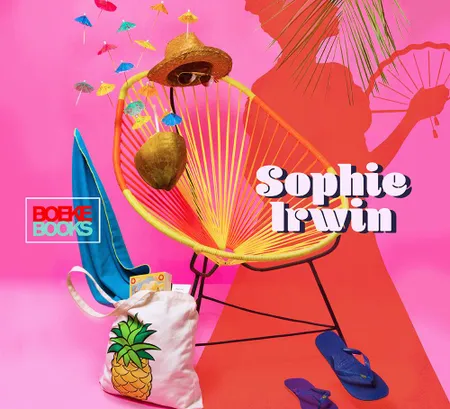EVERYONE would like to believe they pick the most intellectual viewing material on Netflix, but if we're honest, we can admit that after a long day of assaults on brain and body, we sometimes look for mindless entertainment that is not going to require anything more from us.
Then we turn to a romantic comedy — recipe-perfect, predictable, safe — or take a peek at what is underfoot in the ton. If the ton rings a bell, you're probably already familiar with Netflix series such as Bridgerton and Queen Charlotte: A Bridgerton Story, and will be able to enter the world of Sophie Irwin's second novel, A Lady's Guide to Scandal, with fan in hand and alert eyes searching for the next snippet of gossip, forbidden touch or suggestive look).
A Lady's Guide to Scandal is set in England at the beginning of the 19th century. Historical romance depicts many of the bonds imposed on women. The historical milieu is fictionalised but the author paints a world of bygone times to which the reader can escape. Irwin also gives a nod in the direction of Jane Austen's Persuasion, with its similar historical context (as Irwin puts it, “a time when ballrooms were more like battlefields") and thematic similarity in terms of second chances and young love complicated by societal rules.
We can all agree that modernising historical information in Bridgerton and Queen Charlotte affords the viewer enjoyment — especially the inventive intertwining of classical versions of contemporary music and the beautiful characters (wink wink, Regé-Jean Page and Corey Mylchreest). The great success of these series is partly due to this — the viewer is visually carried away and aurally entertained. However, when it comes to a novel, these tricks are not something the author can pull off; after all, she is reliant on words.
The first half of the novel struggles to pick up steam (or shall we say horsepower). I sometimes felt I could burst into tears with the main character Eliza — me from boredom and constant eye-rolling, Eliza because it is her default reaction to almost any situation. Eliza (aka Lady Somerset) is trembling in the wind at the beginning of the novel. She is bullied at the fragile age of 17 into marrying a much older man and forsaking the love of her young life. Ten years later, the old man dies and this is where the fun begins. Eliza is adorable and in demand — but the nasty old sourpuss has determined that she can inherit all his money only if she behaves like a sweet little girl. However, the more Eliza begins to taste the apple of freedom and self-reliance for the first time in her life, the more she wants to devour the whole tree.
Lees hierdie artikel in Afrikaans:
Love triangle
Anyone who can get past the dull start of the novel is rewarded in chapter 15 with writing that unexpectedly enchants and has the reader blushing through the pages. The second half of the novel is certainly a lot less boring than the first and fun (yet predictable) storylines unfold. A love triangle, a lesbian relationship, the breaking of many rules, the woman's position as an artist, wealth gained and lost.
Although the novel depicts the growth of Eliza's character and left me slightly less annoyed with her in the end, she is not the most interesting character to emerge from the pages. Lord Melville made me giggle repeatedly and to my mind he looked like Page. In his shadow, young Lord Somerset is as exciting as a stroll on the boardwalk with your grandmother. Melville is talented, smart, funny and attractive. But what makes him special is that he prefers a woman who also possesses these qualities (and more) — unlike most other men of his time who preferred a respectable woman to everything else.
Melville also has his weaknesses, which contribute to him being one of the novel's most multifaceted characters. I also enjoyed his sister, Caroline, and Eliza's niece, Margaret,who are strong and outspoken. They're razor-sharp and cause a stir (it's probably not a surprise that they're unmarried, and thank goodness for that).
Beyond the entertainment provided by the novel, its greatest strength is probably the way it deals with the tension between choice, duty and desire. British high society in the early 1800s was perpetuated by duty, while modern society places more emphasis on the right to choose. It makes me wonder: is our fascination with this bygone era of propriety and duty emblematic of a yearning to be more directed by rules and regulations? Or do we just look at the characters from this era and think, thank goodness that's not my situation — some kind of schadenfreude? Maybe we just enjoy living out our rebellious side vicariously through these historical characters, encouraging them with a twinkle in the eye to break the rules, regardless of the consequences.
Either way, Eliza's character development goes hand in hand with the tension between what you want to do and what you need to do. And that's the thing that at least makes her character more human. While the novel will evoke this tension (and other historical and topical issues) in the thinking reader, its overriding purpose is certainly not to challenge intellectually; it's pure recreational literature. It's a toe-in-the-sand, cocktail-in-the-hand novel, an escape from our hectic existence. Simply a nice book to read at the end of a long day.
Who, what, where and how much?
A Lady's Guide to Scandal by Sophie Irwin was published by Penguin and costs R353 at Exclusive Books.
♦ VWB ♦
BE PART OF THE CONVERSATION: Go to the bottom of this page to share your opinion. We look forward to hearing from you.



To comment on this article, register (it's fast and free) or log in.
First read Vrye Weekblad's Comment Policy before commenting.